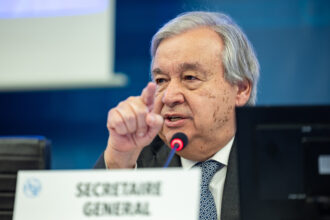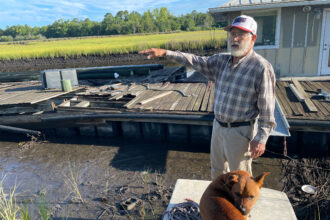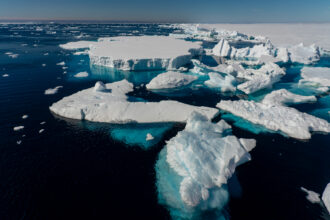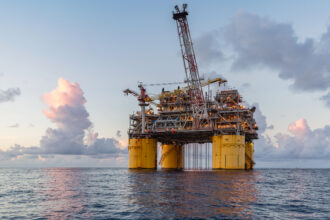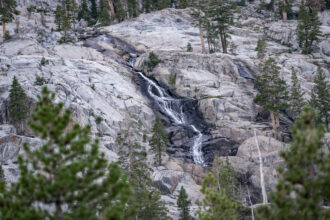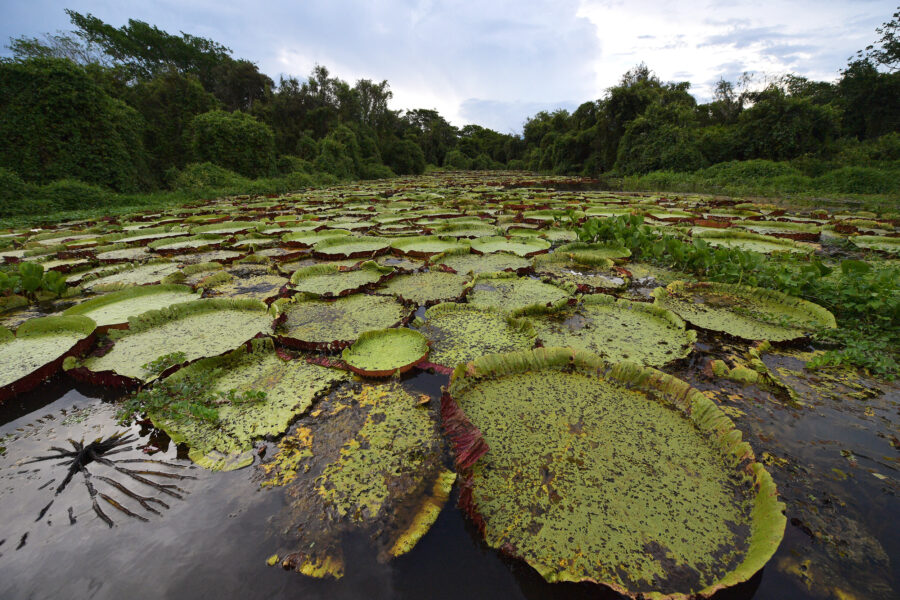The realm of island nations spread across the vast Southwestern Pacific Ocean can conjure up an idyllic image of tiny tropical gems scattered on a deep blue jewelry table.
But those clusters of islands and atolls, reaching 3,000 miles from French Polynesia and Fiji to the Solomon Islands, are home to 2 million of the world’s most climate-vulnerable people, and at risk of being swallowed by inexorably rising seas, United Nations Secretary-General Antonio Guterres warned on Monday while visiting Tonga for the Pacific Islands Forum Leaders Meeting.
“I am in Tonga to issue a global SOS, Save Our Seas, on rising sea levels,” Guterres said, noting that the sea is “overflowing” and Pacific islands are drowning as sea level rises at a rate faster than anytime in at least the past 3,000 years.
“A worldwide catastrophe is putting this Pacific paradise in peril,” he said. “The reason is clear. Greenhouse gases, overwhelmingly generated by burning fossil fuels, are cooking our planet. And the sea is taking the heat, literally.”
During the meeting, the United Nations also released a new technical briefing on the impacts of warming oceans, showing that the rate of sea level rise around many Pacific islands has doubled in just the last few decades.
The report explains that oceans have swelled significantly as they warmed, and shows that, combined with melting glaciers and ice caps, many Pacific Island communities could be swamped within decades.
“In many locations, such as Kiribati and Tuvalu, flooding is currently being experienced at every high tide,” the report states. Under all future climate scenarios, “all Pacific islands may see an order-of-magnitude increase in potential flooding days per year by mid-century, relative to what has been seen in the past decade.”
In the 1980s, Pacific Island developing states averaged fewer that five flooding days per year, but by 2050, in places like Nuku’alofa and Apia, the capital cities of Tonga and Samoa respectively, “the number of flooding days will increase to 35 days per year during the 2050s for an average year,” according to the report.
The average elevation of the Pacific island nations is about 3 to 7 feet above sea level, with 90 percent of the population living within 3 miles of the coast and about half of all infrastructure less than half a mile from the sea.
Another new report for the Pacific Ocean Southwest released today by the World Meteorological Organization showed that regional climate extremes in 2023, most of them storm or flood-related, killed more than 200 people, including notable events like Tropical Cyclones Kevin and Judy hitting Vanuatu within 48 hours of each other in March 2023.
The WMO report also noted that the southwestern Pacific Ocean is warming about 0.7 degrees Fahrenheit per decade, about triple the rate of the global average, and that the frequency of marine heatwaves, which can kill corals and other sea life and cause toxic algal blooms, has doubled since 1980.
Saving the Pacific, Saving Ourselves
“The world must look to the Pacific and listen to the science,”Guterres said. “This is a crazy situation. Rising seas are a crisis entirely of humanity’s making, a crisis that will soon swell to an almost unimaginable scale, with no lifeboat to take us back to safety. But if we save the Pacific,” he added, “we also save ourselves.”
Not all of humanity shares equally in the making of the crisis. Pacific Small Island Developing States, as identified by the U.N., account for only 0.02 percent of global emissions but are facing the impacts caused by greenhouse gas pollution from industrially developed rich countries. Guterres wants to raise this issue to the top of the global agenda and make sure that small island nations are not cast aside.
This story is funded by readers like you.
Our nonprofit newsroom provides award-winning climate coverage free of charge and advertising. We rely on donations from readers like you to keep going. Please donate now to support our work.
Donate NowThe world’s richest countries have an obligation to act now, since they are responsible for about 80 percent of global greenhouse gas emissions, he said.
“The G20, the biggest emitters, with the greatest capacity and responsibility to lead, must be out in front,” he said. And the rest of the world must also follow through at COP29 in November with big increases in finance and other support for vulnerable countries, he added.
Sea level rise could become an even more serious threat if Earth warms more than 1.5 degrees Celsius above the pre-industrial baseline. That temperature limit is at the heart of the Paris Agreement, and Earth’s average temperature has already exceeded that mark for the last 13 months in a row. Some climate projections show the long-term temperature trend line will cross it within the next five years.
And the world’s carbon budget for avoiding breaching that goal has nearly run out. Last year’s emissions totalled about 37 gigatons, with no sign of a decline, and the threshold for the climate target is a total of 200 gigatons, which the world will reach in about 5.4 years at the current rate, according to the United Nations.
With warming of 2 degrees Celsius, some climate models project that the Greenland Ice Sheet and parts of the West Antarctic Ice Sheet could collapse faster than expected, Guterres said.
Under existing climate policies, the planet is expected to warm by almost 3 degrees Celsius by 2100, which could raise sea level by up to 60 feet over the span of centuries, not millennia, he warned, citing recent climate reports like those from the IPCC, but also highlighting the significant uncertainty in the science regarding the future pace of increasing sea levels.
“That spells disaster,” he said. “Wide-ranging and brutal impacts, coming far thicker and faster than we can adapt to them, destroying entire coastal communities. Surging seas are coming for us all, together with the devastation of fishing, tourism and the Blue Economy.”
The current level of warming has already locked in about 3 feet of sea level rise, but the future scale, pace and impacts of the inundation will be determined by actions taken today, he said. “That depends on the decisions we take now. Global leaders must step up to drastically slash global emissions to lead a fast and fair phase-out of fossil fuels.”
Guterres said limiting global warming to 1.5 degrees Celsius is the only way to have “a fighting chance of preventing the irreversible collapse of the Greenland and West Antarctic ice sheet and the catastrophes that accompany them.”
About This Story
Perhaps you noticed: This story, like all the news we publish, is free to read. That’s because Inside Climate News is a 501c3 nonprofit organization. We do not charge a subscription fee, lock our news behind a paywall, or clutter our website with ads. We make our news on climate and the environment freely available to you and anyone who wants it.
That’s not all. We also share our news for free with scores of other media organizations around the country. Many of them can’t afford to do environmental journalism of their own. We’ve built bureaus from coast to coast to report local stories, collaborate with local newsrooms and co-publish articles so that this vital work is shared as widely as possible.
Two of us launched ICN in 2007. Six years later we earned a Pulitzer Prize for National Reporting, and now we run the oldest and largest dedicated climate newsroom in the nation. We tell the story in all its complexity. We hold polluters accountable. We expose environmental injustice. We debunk misinformation. We scrutinize solutions and inspire action.
Donations from readers like you fund every aspect of what we do. If you don’t already, will you support our ongoing work, our reporting on the biggest crisis facing our planet, and help us reach even more readers in more places?
Please take a moment to make a tax-deductible donation. Every one of them makes a difference.
Thank you,







